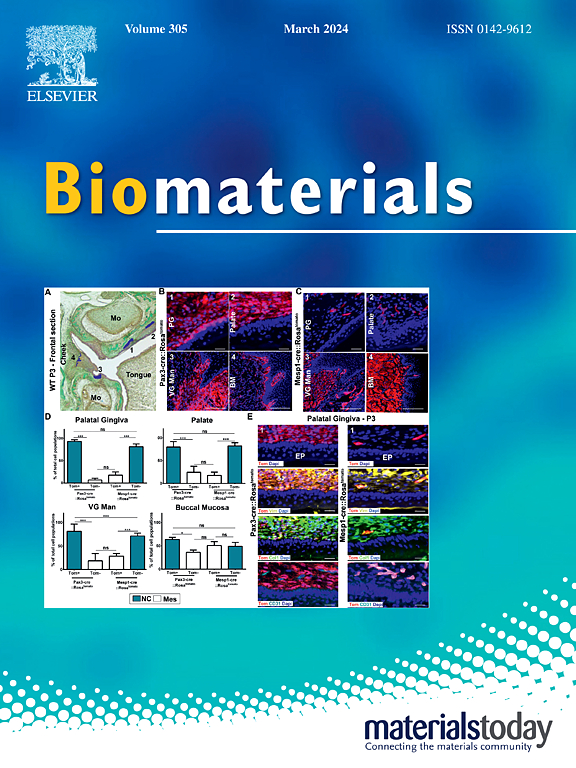Dual-miRNA Guided in-vivo Imaging and Multimodal Nanomedicine Approaches for Precise Hepatocellular Carcinoma Differentiation and Synergistic Cancer Theranostics using DNA Hairpins and Dual-Ligand functionalized Zirconium-MOF Nanohybrids
IF 12.8
1区 医学
Q1 ENGINEERING, BIOMEDICAL
引用次数: 0
Abstract
As one of the most common and heterogeneous liver malignancies, hepatocellular carcinoma (HCC) remains a significant clinical challenge due to the lack of biomarkers for early diagnosis, challenges in accurate subtyping, and limitations of current therapeutic strategies with poor efficacy. Herein, based on DNA hairpin probes and dual-ligand zirconium (Zr)-based metal-organic frameworks (DMOFs), the multifunctional nanohybrids (DMOF@MnCO@CuS@Hairpin probe, DMCH) were developed to overcome these diagnostic and therapeutic obstacles. Two improved DNA molecular beacons and APE1 enzyme within HCC cells were utilized for sensitive miRNAs imaging in vivo with high accuracy to differentiate HCC subtypes precisely. Furthermore, this “all-in-one” theranostic platform not only facilitates the generation of active oxygen species and conversion of near-infrared light into heat, but also releases carbon monoxide to inhibit the expression of HSP70 protein to improve photothermal (PTT) therapy efficiency during laser radiation, which enables PTT, photodynamic (PDT), chemodynamic (CDT), and gas therapy (GAT) for HCC treatment simultaneously. The developed nano-theranostics platform provides a novel way for efficient early screening, diagnosis, and intervention of HCC, and paves the path for future “bench-to-bedside” design of theranostics.

利用DNA发夹和双配体功能化锆- mof纳米杂化物,双mirna引导的体内成像和多模态纳米医学方法用于肝细胞癌的精确分化和协同癌症治疗
肝细胞癌(HCC)是最常见的异质性肝脏恶性肿瘤之一,由于缺乏早期诊断的生物标志物、准确的亚型鉴定面临挑战,以及目前治疗策略的局限性和疗效不佳,它仍然是一项重大的临床挑战。本文基于DNA发夹探针和双配体锆(Zr)基金属有机框架(DMOF),开发了多功能纳米混合物(DMOF@MnCO@CuS@发夹探针,DMCH),以克服这些诊断和治疗障碍。利用两种改良的DNA分子信标和HCC细胞内的APE1酶,在体内进行敏感的miRNAs成像,准确区分HCC亚型。此外,该 "一体化 "治疗平台不仅能产生活性氧,将近红外光转化为热能,还能在激光照射过程中释放一氧化碳抑制HSP70蛋白的表达,提高光热(PTT)治疗效率,从而实现PTT、光动力(PDT)、化学动力(CDT)和气体疗法(GAT)同时治疗HCC。所开发的纳米治疗仪平台为高效地早期筛查、诊断和干预 HCC 提供了一种新方法,并为未来治疗仪的 "从台架到床边 "设计铺平了道路。
本文章由计算机程序翻译,如有差异,请以英文原文为准。
求助全文
约1分钟内获得全文
求助全文
来源期刊

Biomaterials
工程技术-材料科学:生物材料
CiteScore
26.00
自引率
2.90%
发文量
565
审稿时长
46 days
期刊介绍:
Biomaterials is an international journal covering the science and clinical application of biomaterials. A biomaterial is now defined as a substance that has been engineered to take a form which, alone or as part of a complex system, is used to direct, by control of interactions with components of living systems, the course of any therapeutic or diagnostic procedure. It is the aim of the journal to provide a peer-reviewed forum for the publication of original papers and authoritative review and opinion papers dealing with the most important issues facing the use of biomaterials in clinical practice. The scope of the journal covers the wide range of physical, biological and chemical sciences that underpin the design of biomaterials and the clinical disciplines in which they are used. These sciences include polymer synthesis and characterization, drug and gene vector design, the biology of the host response, immunology and toxicology and self assembly at the nanoscale. Clinical applications include the therapies of medical technology and regenerative medicine in all clinical disciplines, and diagnostic systems that reply on innovative contrast and sensing agents. The journal is relevant to areas such as cancer diagnosis and therapy, implantable devices, drug delivery systems, gene vectors, bionanotechnology and tissue engineering.
 求助内容:
求助内容: 应助结果提醒方式:
应助结果提醒方式:


